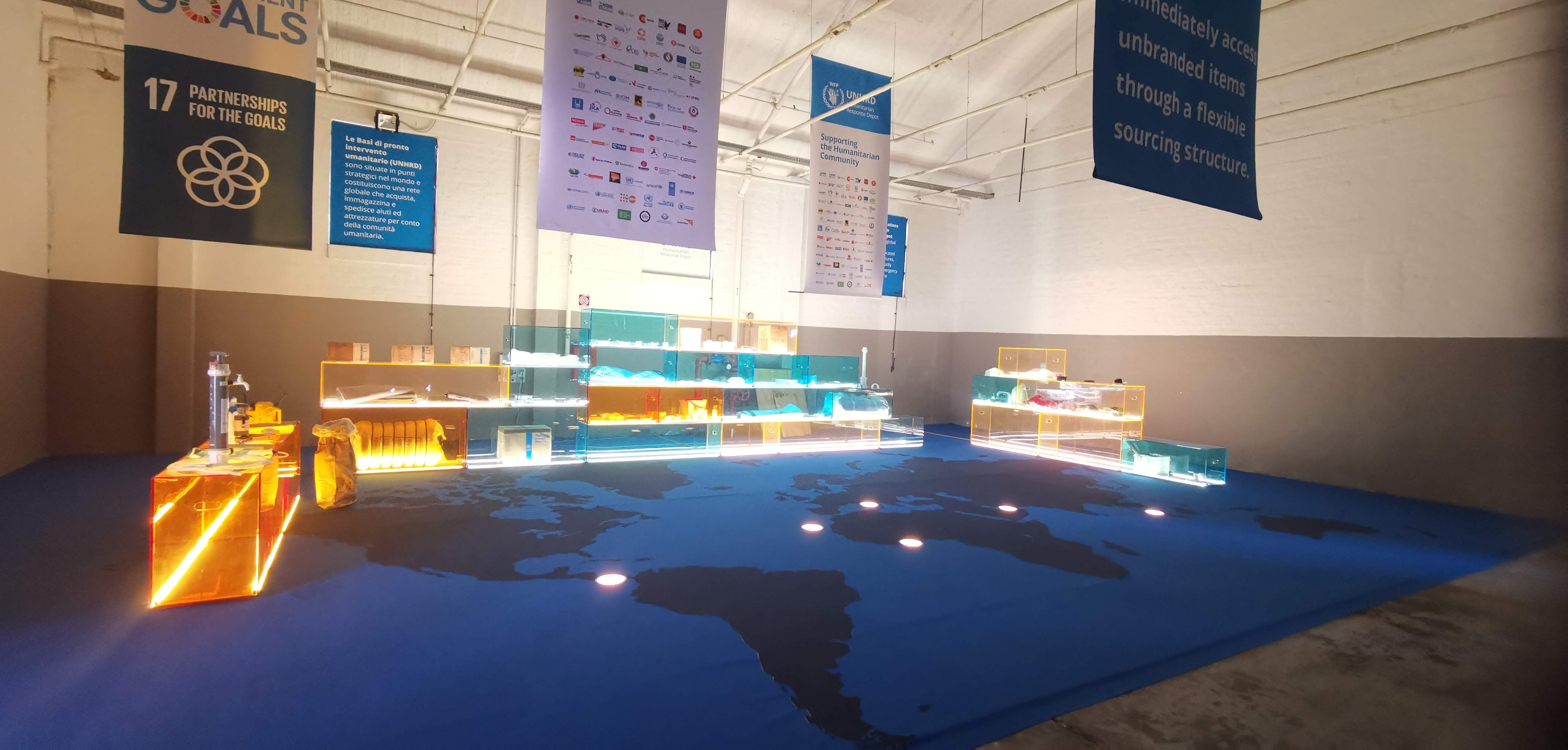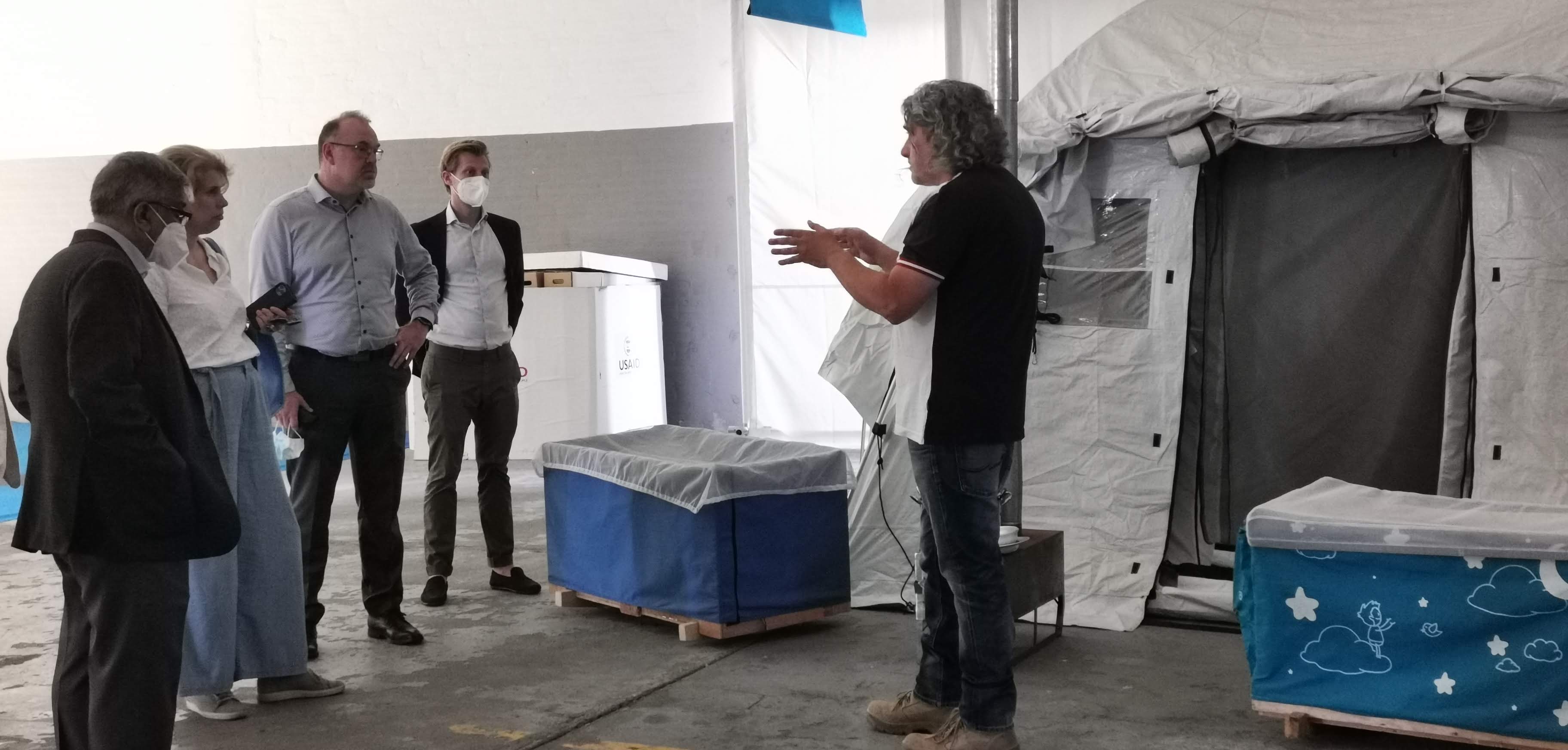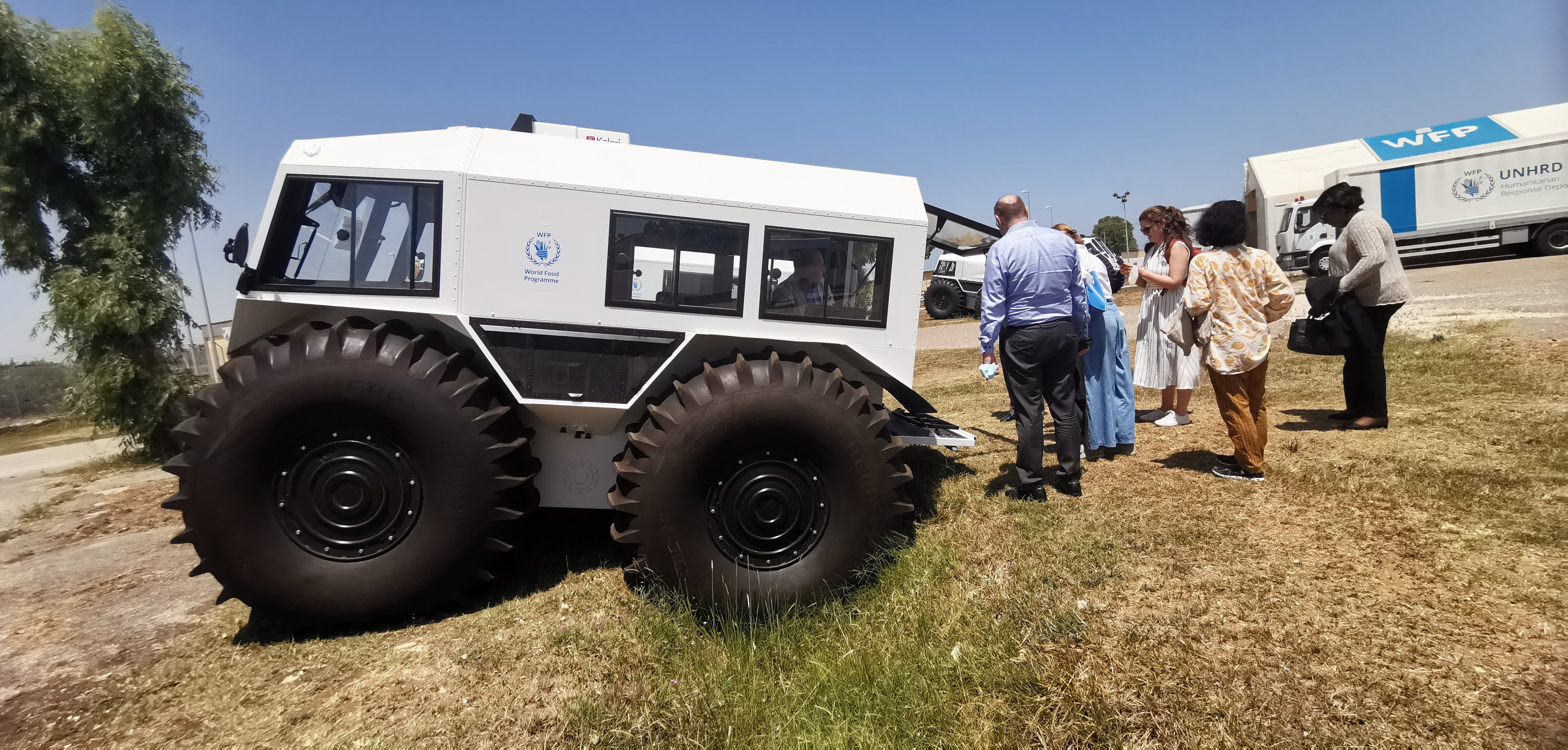On 5 July, eight members of the WFP Executive Board had the opportunity to learn about the history, evolution, and operations of the United Nations Humanitarian Response Depot (UNHRD), WFP’s global network that has been providing supply chain solutions to the international humanitarian community since 2000. As an annual event on the WFP Board calendar, this is an opportunity for members to see first-hand the emergency response network’s capacity.
The visit begins as the plane is landing, as we spot containers with the "UN" logo and a big hangar marked "UNHRD". Once landed, we do not go to the arrivals, as would be expected in most airports, instead we are picked up by Marta Laurienzo, UNHRD Network Coordinator and Brindisi Hub Manager and her team, who take us to the San Vito dei Normanni premises inside the airport, just a few kilometers from the city. UNHRD Brindisi is generously hosted by the Government of Italy which also covers, on an annual basis for the past 22 years, the entire running costs of the hub.
UNHRD plays a frontline role in emergency preparedness and response worldwide, offering services of warehousing, inspection, and handling of prepositioned relief items for its numerous partners at no cost. Additionally, UNHRD offers a wide range of related services, such as procurement, transport, technical assistance and technological innovation through its internal Research & Development facility, UNHRD Lab. In combination, UNHRD is able to provide holistic solutions to its partners, facilitating their humanitarian response. Among other services, UNHRD provides a range of fully equipped training services and facilities across the worldwide Network where various humanitarian trainings can be held.
Our first stop is at the museum, a unique display conceptualized by our WFP colleagues in Brindisi, created by using materials recycled from stockpiles, such as pellets, as supports for illustrated panels, and wheels of aircraft used in operations as the bases for photo albums. The result showcases the passion that these colleagues have for the work of the UNHRD which also shines through as Andrea Tornese, UNHRD Communication Specialist, and Marta introduce us to the UNHRD world.
The museum is inside an area of the depot and is dedicated to the history of UNHRD, which, with its four other hubs and an antenna located near disaster-prone areas - Accra (Ghana), Dubai (United Arab Emirates), Kuala Lumpur (Malaysia), Panama City (Panama), and Las Palmas (Spain) - has its roots in a forward-looking initiative undertaken by the Italian Government in the mid-1980s with the goal of enabling the United Nations and humanitarian organizations to pre-position relief items, ready for dispatch in emergency contexts.
Members were then briefed on the Hub's expansion plan funded by the Italian Ministry of Foreign Affairs and International Cooperation, including the UNHRD Lab – a research and development unit that reviews, optimizes, and tests products used in humanitarian settings - the International Conference Center, and the Training and Simulations Center for UN activities, academies, and university projects. A visit of the new simulations area took place in the afternoon (further details below).
The visit continues in the main warehouse, part of the total 10000sqm of covered storage space, to be introduced to the most common relief items and equipment stocked at UNHRD hubs and delivered across the world to people affected by crises and humanitarian organizations to set up responses: prefabs, family tents, storage units, medical supplies, hygiene kits and blankets. In this warehouse, as you look up, you see the logos of many of UNHRD's partners printed on recycled jute bags. Originally, five humanitarian organizations relied on the UNHRD Network. Today UNHRD serves 100 partners ranging from UN agencies, governmental and non-governmental organizations.

This warehouse also hosts a Showroom where basic items deployed in response to emergencies as well as items resulting from the efforts of the UNHRD Lab - where repackaging and green technologies are at the heart of humanitarian research and development - can be seen, like the “Cradle Tent”. With infants and children among the most vulnerable in crisis, the "Cradle Tent," once the tent is set up, allows the wooden crate in which the tent itself is stored to be reused as a crib with rockers, mattress, sheets, and toys.

Outside, the visitors had the opportunity to get familiar with a Sherp, an amphibious truck, like a tank with inflatable wheels, often deployed in response to cyclones. The Sherp arrives where regular trucks get stuck because of waterlogged dirt roads, reaching isolated communities. This logistics solution is also complemented by the use of drones, which make emergency responses very effective, as was the case for Cyclone Idai in 2019 in Mozambique.

With the Hub's expansion plan, the training facilities will become the largest simulation site in the Network. Representatives visited the new area recently made available by the Italian Government to WFP for training activities. As we drive through the streets named after protagonists of history, Andrea tells us that until the late 1990s the area was part of a US Air Force base. As he tells us this, in the eyes of those who visit flows the life of the past, imagining what it might have been like for military personnel and their families to work and live here. Looking forward, the site will be upgraded mainly from a security standpoint to preserve the post-disaster grounds which offer the ideal setting for scenario-based humanitarian trainings and simulations.
Our visit takes place on the same day that WFP and the World Health Organization (WHO) are holding a follow-up workshop on the INITIATE2 project which was launched on the margins of G20 ministerial event hosted by the Italian Government and WFP at UNHRD Brindisi on 30 June 2021. It is an opportunity for members to learn details directly from those involved in the project, which aims at developing standardized, innovative solutions such as disease-specific field facilities and kits, and test these solutions in real-life scenarios, by leveraging the existing infrastructure and experience of UNHRD Brindisi. We learn from team members that the organizations will also train logistics and health responders on their installation and use, contributing to their capacity to respond in health crises.

The day ends with a visit to the UNHRD facilities at Brindisi military airport where the hub was originally established. While expanding its facilities within the San Vito dei Normanni premises in an effort to set up a more robust logistics platform, the hub maintains a hangar-style warehouse, the one we saw from the plane, to stock highly requested items, to store medicines and health kits in the temperature-controlled rooms and cold rooms and to prepare cargos and rapidly transport it to the tarmac.
Visiting UNHRD in Brindisi, meeting the WFP staff who guided us throughout the visit, and witnessing the cooperation between UN agencies gave Board members a better understanding of the importance of the Hub Network as part of the backbone of WFP's operations, as well as the extension of its expertise to partners and the broader humanitarian community, helping them achieve their operational goals. To echo the words of the WFP Executive Board President H.E. Md. Shameem Ahsan, Ambassador and Permanent Representative of Bangladesh while thanking the WFP staff members in Brindisi, they allowed us to better understand and have a sense of real life in emergency settings.
From right:
- List B, Mr. Manash Mitra, Economic Counsellor and Alternate Permanent Representative of Bangladesh;
- List D Representative: Ms. Rebecca Entringer, Counsellor and Alternate Permanent Representative of Luxembourg;
- List B Convenor and WFP Executive Board President: H.E. Md. Shameem Ahsan, Ambassador and Permanent Representative of Bangladesh;
- List C Convenor: H.E. Mr. Carlos Bernardo Cherniak, Ambassador and Permanent Representative of Argentina
- List E Representative: H.E. Mr. Zsolt Belánszky-Demkó, Ambassador and Permanent Representative of Hungary
- WFP UNHRD Brindisi Hub Manager and UNHRD Network Coordinator, Ms. Marta Laurienzo
- List A Representative: Ms. Phyllis Martha Klorkor Mends, Minister Counsellor and Alternate Permanent Representative of Ghana
- List D Representative: H.E Mrs. Alexandra Valkenburg, Ambassador and Permanent Representative of the European Union
- List D, Mr. Alexander Ernst, First Secretary and Alternate Permanent Representative of Germany
- WFP Deputy Secretary to the Executive Board, Ms. Mihoko Tamamura
- WFP Communication Specialist, Mr. Andrea Tornese
- Anna Maria Scianaro, UNHRD Brindisi Pharmacist
